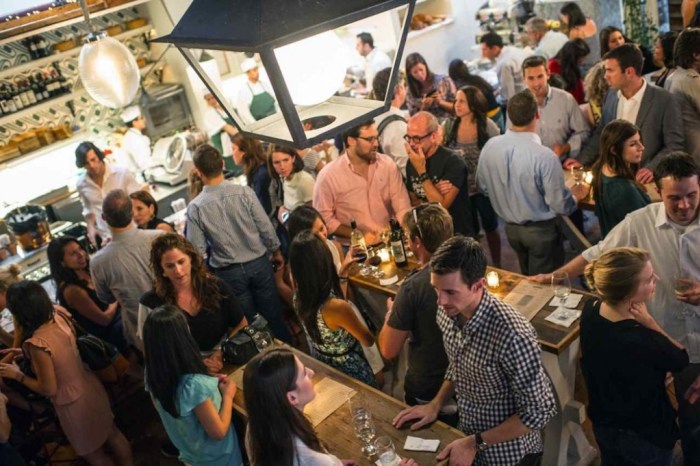Is It Me Or Are Restaurants Getting Louder?
“No I don’t want to go there. And not there either! How about we forget the restaurant and just eat at home!” Elaine just looked at her husband and shook her head. “Lenny, what’s wrong. Eating out was something we always enjoyed, Now I need a crowbar to get you to go to a restaurant.”
Lenny paced around the living room and finally spoke up. “Elaine,” he said. “It’s the noise. It seems that nowadays every restaurant is so loud. And it’s not music. It’s clanking and banging and voices that carry. We sit at a little table, right across from each other and we can’t even hear our own conversation.. Eating out isn’t for us old folks. Restaurants today are for a younger crowd.”
Lenny’s lament isn’t limited to the older generation. And the noisy restaurant complaint doesn’t apply only to hearing aid users who have difficulty adjusting the mechanism to accommodate ambient noise. No, according to a lengthy piece in the November 27, 2018 edition of The Atlantic, (“How Restaurants Got So Loud,”) journalist Kate Wagner reports that the noise level in American restaurants of is appreciably higher – to the detriment of patrons and staff alike.
Armed with a calibrated decibel meter, Wagner tested the noise level in a variety of different restaurants, from coffee shops to fine dining, and what she found corroborates the complaint voiced by many diners. Restaurants are just too loud- so loud in fact that conversations are impossible and a migraine should be a menu item. Wagner says, “Noise levels become harmful to human hearing above 85 decibels, and she reports that restaurants from Baltimore to New York City were often louder than this 85 decibel safety level, Wagner found decibel levels hitting 86 at a brunch in a food court and she recorded 90 decibels at a pub during a Friday afternoon happy hour.
So what accounts for the change from quiet to noisy that characterizes so many restaurants? Wagner (whose resume includes architecture and design experience) explains that the cultural shift from formal to casual dining is to blame. As recently as thirty years ago dining was more elegant; soft music played in dining rooms where lush carpeting, brocade draperies and upholstered chairs were not only elegant but maybe more important, these design elements worked together to absorb sound. Wagner writes that today “Restaurants are so loud because architects don’t design them to be quiet. Much of this shift in design boils down to changing conceptions of what makes a space seem upscale or luxurious, as well as evolving trends in food service. Right now, high-end surfaces connote luxury, such as the slate and wood.” Wagner writes that In addition many upscale eateries feature a proponderance of stainless steel, exposed ceilings and kitchens open to the dining room where patrons can watch their food as it is prepared.
Wagner goes on to say that “These design features are a feast for the eyes, but a nightmare for the ears,” and she reminds us that the absence of soft fabrics and high ceilings mean that nothing is absorbing the sound. As Wagner puts it, “a room full of hard surfaces serves as a big sonic mirror, reflecting sound around the room. The result is a loud space that renders speech unintelligible.”
If the increase in restaurant decibel level is bad for one’s hearing, the cultural effects are equally detrimental. According to Wagner, “Noise also degrades the thing that eating out is meant to enhance – culture: a shared social experience that rejuvenates, rather than harms, its participants.”
Is it any wonder that Lenny and many others like him are so upset. “I’ve been to Bar Mitzvah dinners and wedding receptions where I can’t hear myself think,” says Lenny who faults the venue, and not the music, for creating such a negative experience. “We’re shouting across the table, just to have a conversation. It’s so uncomfortable that I just don’t want to go.”
Lenny is not alone. Restaurant patrons are lodging more complaints and others, like Lenny, are staying home; so much so that businesses are noticing the downward trend. But getting back to what Lenny would call a more civilized dining experience is not happening to any great degree. Why? According to author and design expert Allison Perlman, loud restaurants bring in more profit. In her book, Smart Casual: The Transformation of Gourmet Restaurant Style in America, Perlman goes on to say that its cheaper and easier to construct a restaurant interior out of hard surfaces – they’re easier to clean, repair and replace, while loud restaurants encourage the adrenalin rush that comes from eating quickly, drinking more alcohol and wolfing down desserts.
For us Jews the book of Proverbs provides a guideline for the enjoyment of a meal when we read about the eating habits of righteous persons versus those who are wicked. “The righteous eat to satisfy their souls, but the stomach of the wicked still wants.” (13:25). What could be more soul-satisfying than eating a meal in a calm and tranquil venue. Or as Allison Wagner concludes, “I’m not calling for the return of stuffy, socially stratified fine dining …. Rather, I’d welcome a return of a more relaxed and serene dining experience, one in which I can hear my dinner companion, avoid drinking too much, and dodge a stress headache following an after-work drink.” I believe that Lenny would agree.

